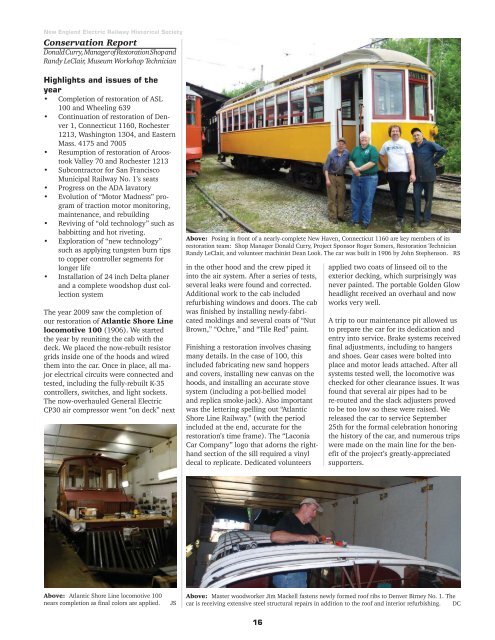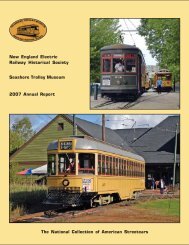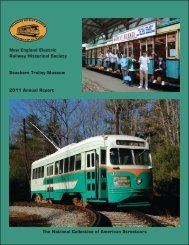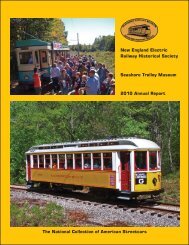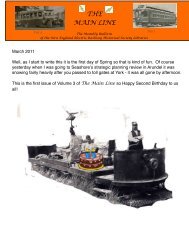2009 Annual Report - the Seashore Trolley Museum
2009 Annual Report - the Seashore Trolley Museum
2009 Annual Report - the Seashore Trolley Museum
Create successful ePaper yourself
Turn your PDF publications into a flip-book with our unique Google optimized e-Paper software.
New England Electric Railway Historical Society<br />
Conservation <strong>Report</strong><br />
Donald Curry, Manager of Restoration Shop and<br />
Randy LeClair, <strong>Museum</strong> Workshop Technician<br />
Highlights and issues of <strong>the</strong><br />
year<br />
• Completion of restoration of ASL<br />
100 and Wheeling 639<br />
• Continuation of restoration of Denver<br />
1, Connecticut 1160, Rochester<br />
1213, Washington 1304, and Eastern<br />
Mass. 4175 and 7005<br />
• Resumption of restoration of Aroostook<br />
Valley 70 and Rochester 1213<br />
• Subcontractor for San Francisco<br />
Municipal Railway No. 1’s seats<br />
• Progress on <strong>the</strong> ADA lavatory<br />
• Evolution of “Motor Madness” program<br />
of traction motor monitoring,<br />
maintenance, and rebuilding<br />
• Reviving of “old technology” such as<br />
babbitting and hot riveting.<br />
• Exploration of “new technology”<br />
such as applying tungsten burn tips<br />
to copper controller segments for<br />
longer life<br />
• Installation of 24 inch Delta planer<br />
and a complete woodshop dust collection<br />
system<br />
The year <strong>2009</strong> saw <strong>the</strong> completion of<br />
our restoration of Atlantic Shore Line<br />
locomotive 100 (1906). We started<br />
<strong>the</strong> year by reuniting <strong>the</strong> cab with <strong>the</strong><br />
deck. We placed <strong>the</strong> now-rebuilt resistor<br />
grids inside one of <strong>the</strong> hoods and wired<br />
<strong>the</strong>m into <strong>the</strong> car. Once in place, all major<br />
electrical circuits were connected and<br />
tested, including <strong>the</strong> fully-rebuilt K-35<br />
controllers, switches, and light sockets.<br />
The now-overhauled General Electric<br />
CP30 air compressor went “on deck” next<br />
Above: Posing in front of a nearly-complete New Haven, Connecticut 1160 are key members of its<br />
restoration team: Shop Manager Donald Curry, Project Sponsor Roger Somers, Restoration Technician<br />
Randy LeClair, and volunteer machinist Dean Look. The car was built in 1906 by John Stephenson. RS<br />
in <strong>the</strong> o<strong>the</strong>r hood and <strong>the</strong> crew piped it<br />
into <strong>the</strong> air system. After a series of tests,<br />
several leaks were found and corrected.<br />
Additional work to <strong>the</strong> cab included<br />
refurbishing windows and doors. The cab<br />
was finished by installing newly-fabricated<br />
moldings and several coats of “Nut<br />
Brown,” “Ochre,” and “Tile Red” paint.<br />
Finishing a restoration involves chasing<br />
many details. In <strong>the</strong> case of 100, this<br />
included fabricating new sand hoppers<br />
and covers, installing new canvas on <strong>the</strong><br />
hoods, and installing an accurate stove<br />
system (including a pot-bellied model<br />
and replica smoke-jack). Also important<br />
was <strong>the</strong> lettering spelling out “Atlantic<br />
Shore Line Railway.” (with <strong>the</strong> period<br />
included at <strong>the</strong> end, accurate for <strong>the</strong><br />
restoration’s time frame). The “Laconia<br />
Car Company” logo that adorns <strong>the</strong> righthand<br />
section of <strong>the</strong> sill required a vinyl<br />
decal to replicate. Dedicated volunteers<br />
applied two coats of linseed oil to <strong>the</strong><br />
exterior decking, which surprisingly was<br />
never painted. The portable Golden Glow<br />
headlight received an overhaul and now<br />
works very well.<br />
A trip to our maintenance pit allowed us<br />
to prepare <strong>the</strong> car for its dedication and<br />
entry into service. Brake systems received<br />
final adjustments, including to hangers<br />
and shoes. Gear cases were bolted into<br />
place and motor leads attached. After all<br />
systems tested well, <strong>the</strong> locomotive was<br />
checked for o<strong>the</strong>r clearance issues. It was<br />
found that several air pipes had to be<br />
re-routed and <strong>the</strong> slack adjusters proved<br />
to be too low so <strong>the</strong>se were raised. We<br />
released <strong>the</strong> car to service September<br />
25th for <strong>the</strong> formal celebration honoring<br />
<strong>the</strong> history of <strong>the</strong> car, and numerous trips<br />
were made on <strong>the</strong> main line for <strong>the</strong> benefit<br />
of <strong>the</strong> project’s greatly-appreciated<br />
supporters.<br />
Above: Atlantic Shore Line locomotive 100<br />
nears completion as final colors are applied.<br />
JS<br />
Above: Master woodworker Jim Mackell fastens newly formed roof ribs to Denver Birney No. 1. The<br />
car is receiving extensive steel structural repairs in addition to <strong>the</strong> roof and interior refurbishing. DC<br />
16


